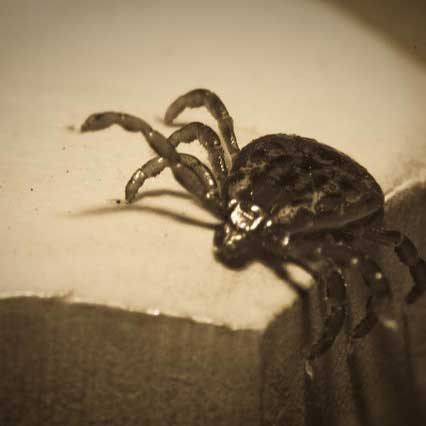
What is Tick borne disease?
Tick borne disease (TBD) refers to various infectious pathogens (bacteria, viruses, fungi, protozoa, parasites) that can be transmitted via the bite of a tick. For simplicity, many use “Lyme and tick borne disease” to refer to this vast array of pathogens. When bitten by a tick, it is common to be exposed to more than one infectious agent, which results in various clinical presentations which we refer to as “tick borne disease”. Variables such as co-infections, immune status, nutrition, genetics,strains of different organisms, and re-activation of previous infections may play a role in how a patient presents for medical attention. This may result in improper diagnosis and treatment with a prolonged course of infection for many patients with TBD. Lyme disease is known to cause a type of immune suppression (particularly when Babesia co-infection is present), that can result in re-activation of past viral infections or common bacteria.
a few infections transmitted by ticks:
Lyme disease (Borreliosis, most commonly caused by B. burgdorferi in the United States; B. afzellii, B. garinii most commonly seen in Europe)
Borrelia mayonii
Borrelia miyamotoi
Anaplasmosis
Ehrlichiosis
Rickettsia species (R. rickettsii, R. parkeri, R. helvetica, e.g.)
Babesia species (B. microti, B. duncani, e.g.)
Mycoplasma pneumoniae
Re-activation infections (EBV/mononucleosis, HHV-6, Chlamydia pneumoniae, Bartonella species, etc.; Note: Bartonella has been associated with tick borne disease, but the mode of transmission via ticks is still controlversial.)
Relapsing fever Borrelia (caused by B. hermsii)
Viral infections (Powassan virus; Bourbon Virus, Heartland Virus, Colorado Tick fever in other parts of the United States)
Tularemia
Symptoms
Because of the likelihood of co-infections or re-activation, the clinical presentation of Lyme and TBD (tick borne diseases) is variable. Below is a list of some associated symptoms:
• Bull’s eye rash (a.k.a. Erythema Migrans or EM), may be solid, can be raised or slightly itchy, ranges from pale pink to deep red, may be single or multiple. EM rash is diagnostic for Lyme disease. Other types of rashes can be seen as well. Many patients with the persistent or chronic form of the infection have recurrent EM type rashes that come and go.
- fevers, chills, malaise
- fatigue
- facial palsy (or numbness/ neuropathic sensations on the face/head)
- headaches
- shortness of breath (“air hunger” or “unable to take a full breath”)
- stiff neck or neck pain
- disturbed sleep (often treatment resistant)
- depressed mood, anxiety
- migratory joint pain +/- swollen joint
- shooting pain, numbness, tingling
- tinnitus (ringing/ buzzing in the ears)
- palpitations
- dizziness/ poor balance
- gastrointestinal symptoms (can mimic IBS)
- brain fog (difficulty thinking, mild memory/cognitive difficulty)
- other: jaw pain, rib soreness, abdominal pain
Diagnosis
The diagnosis of Lyme disease is based on both clinical and laboratory information. In some people who have recently been exposed to a tick infected with Lyme bacteria, a Bull’s Eye rash (or Erythema Migrans) is sufficient to make a diagnosis. A blood test will be negative at this point unless the individual had been exposed in the past. The infection spreads to distant locations (joints, nervous system, liver, heart, muscle) within a few weeks of infection, if not sooner. Patients often complain of joint pain which can be migratory, nervous system complaints (shooting pains, numbness, palpitations, dizziness with low blood pressure, numbness or weakness of the facial muscles, headaches, cognitive/memory problems) and sleep disturbances.
After being infected for 4 weeks or so, a Lyme Western Blot is sometimes positive. If someone recieved a dose or two of antibiotic right afterta tick bite (“post exposure prophylazis”), this can result in a falsely negative test. Currently the CDC (and IDSA) recommends a “Two Tier Test” checking the ELISA and then Western Blot. This approach can result in many “false negatives” (the test is negative despite presence of infection) so some physicians opt to check a Western blot without an ELISA. If infected by Lyme for several years, a person’s ability to make antibodies may be impaired, which can also result in a “false negative” test result. Sometimes specialized tests can be ordered to characterize a person’s likelihood of having an active Lyme infection (such as an ELISPOT test, CD57 test, C6 peptide, IgG Subclasses, IgG, IgM, IgA). Some commercial labs are now offering combination Immunoblot tests that check for various types of Borrelia that can cause Lyme disease ( such as B afzelii, B garinii, B mayonii, B californiensis, B burgdorferi B31, B burgdorferi 297).
At the time of this writing this summary, there is no true gold standard test for Borrelia burgdorferi (Lyme disease). Antibody based testing (ELISA and Western blot) have limitations, as noted above. It is extremely difficult tog row this bacteria in cluture and PCR is typically more helpful early in the course of infection.
Treatment
The above mentioned bacterial infections usually respond to antibiotics. Because of the various forms of Borrelia (spirochete, cyst, biofilm), it is necessary to treat with combination antibiotics. Many patients with early infection (e.g. EM rash, fever) progress to the chronic or late phase despite treatment as recommended by the CDC (i.e. 14-21 days of doxycycline). For patients who have had longstanding infections, a longer treatment regimen is often necessary.
IMPORTANT: If you develop flu-like symptoms in the summer in an endemic area, be suspicious of a TBD even if you do not recall a tick bite. It is not recommended to take post exposure prophylaxis (i.e. one or two doses of doxycycline after a tick bite) for the reasons noted above
FAQ’s:
We frequently get ask questions relating to ticks and tick-borne diseases. Look HERE for our answers.
About the Author
Jean J. Barry, MD is a practicing physician in Concord, MA who treats patients with Lyme/ Tick borne disease. Dr. Barry is Board Certified in Internal Medicine, earned her MD from NYU School of Medicine, undergraduate degree from Dartmouth College and completed her internship/ residency at Harvard Medical School/ Beth Israel Deaconess Hospital. She has a personal interest in autoimmune disorders, Lyme/ Tick borne disease and functional medicine. She is a member of the Carlisle Board of Health Lyme disease Subcommittee and is a member of ILADS (the International Lyme and Associated Diseases Society).
Resources
www.tickreport.com
www.cdc.gov/ticks/index.html
www.ilads.org
www.lymediseaseassociation.org
www.columbia-lyme.org
www.tickencounter.org/prevention/time_to_transmission
https://www.ncbi.nlm.nih.gov/pmc/articles/PMC4774835/
[/et_pb_text][/et_pb_column][/et_pb_row][/et_pb_section]

